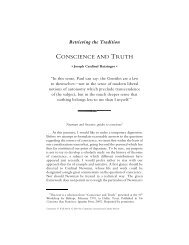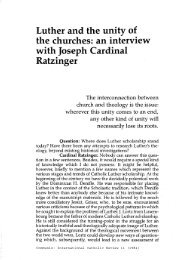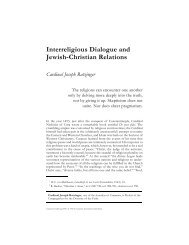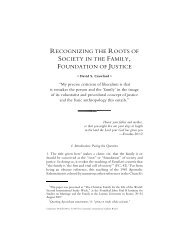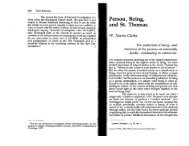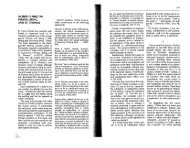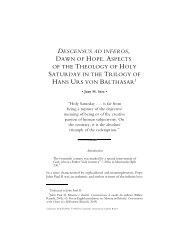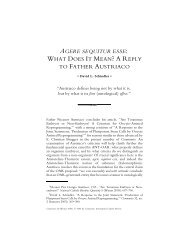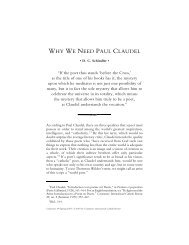Juan Sara. Secular Institutes According to Hans Urs ... - Communio
Juan Sara. Secular Institutes According to Hans Urs ... - Communio
Juan Sara. Secular Institutes According to Hans Urs ... - Communio
You also want an ePaper? Increase the reach of your titles
YUMPU automatically turns print PDFs into web optimized ePapers that Google loves.
<strong>Secular</strong> <strong>Institutes</strong> 321<br />
The Spirit, witness and fruit of this mystery, is given <strong>to</strong> all<br />
believers. But he is given in a qualified way <strong>to</strong> those called <strong>to</strong><br />
continue Mary’s poor, virginal, and obedient reception of the<br />
mystery at the foot of the cross. The mission of the consecrated,<br />
then, finds its native ground, its matrix, when they “stand” with<br />
Christ and his mother at the timeless moment in which heaven and<br />
earth are perfectly united in the Son’s death out of love and in the<br />
breathing forth of the Spirit from the Son’s flesh in<strong>to</strong> the body of his<br />
Bride, the Church. The heteronomy of sin is transformed in<strong>to</strong> a<br />
common rule of love. The spiration of the Spirit by the Father and<br />
the incarnate Son (filioque) now extends <strong>to</strong> include humanity itself in<br />
the eternal thanksgiving that links the divine persons. Obeying the<br />
Son in his thanksgiving <strong>to</strong> the Father in the Holy Spirit (who<br />
embodies the “rule” of the Christian’s loving obedience), the<br />
consecrated person can be at one and the same time child-like before<br />
God and mature before the world, simple and ingenuous and<br />
prudent. He can pray and work, he can cultivate the growth of his<br />
profession and of his vocation. And he can do all this in unity,<br />
inasmuch as all of the aspects just mentioned express the one selfdonation<br />
of Christ <strong>to</strong> the Father thanks <strong>to</strong> the Spirit. 34<br />
The secular institutes belong, by their very origin, where the<br />
world is concretely taken up in<strong>to</strong> God. Their very form is rooted in<br />
the free circumincessio between God and the world. The two hands of<br />
the Father are at work in them, fashioning from the world a response<br />
worthy of the divine love.<br />
We could make the same point drawing on an original<br />
intuition of Adrienne von Speyr: God needs more love than he<br />
receives from the world and human beings need more love than they<br />
receive from the world. The secular institutes aspire <strong>to</strong> place<br />
themselves at the intersection of these two needs. Where these needs<br />
intersect, vicarious, eucharistic interchange becomes possible. This<br />
“where” is, once again, the foot of the cross. At the foot of the cross,<br />
both necessities—the Father’s desire <strong>to</strong> be loved by his creation and<br />
human beings’ desire <strong>to</strong> be loved by God and by their brothers—are<br />
superabundantly fulfilled. The most needy, those who patiently seek<br />
God’s love in their wretchedness, those praised in the Beatitudes<br />
34 “We then understand: it is the Holy Spirit who mediates this atmosphere of the<br />
‘<strong>to</strong>wards.’ It is embodied in the Son, but communicated in the Spirit. And then<br />
everything goes <strong>to</strong> the Father, whom we do not see” (Speyr, Objektive Mystik, 572).



